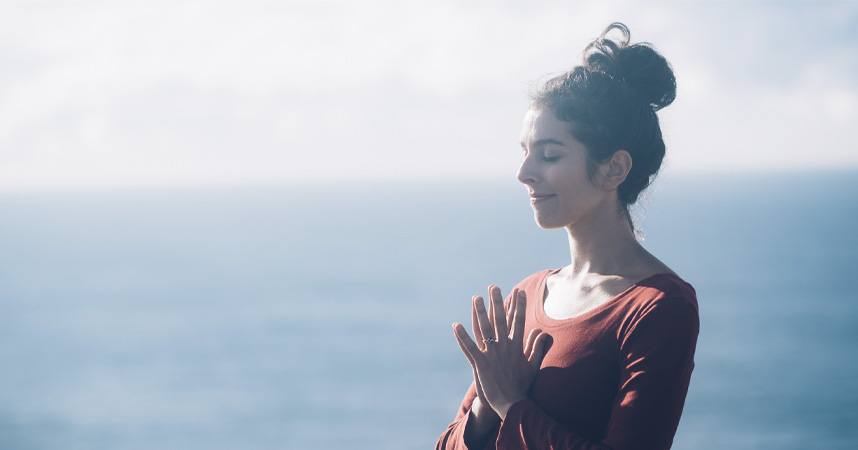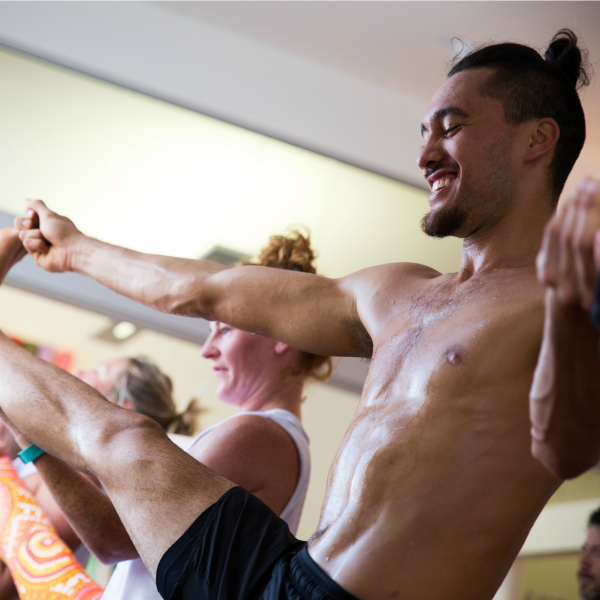18 Feb How to become a yoga teacher in Australia

Written by Paul Ewart ・Published in Good Health Magazine
What do you think of when you hear the word ‘yoga’? A room full of sleek, impossibly flexible, activewear-clad young things making pretzel shapes on a mat, all the while maintaining beatific Zen-like smiles, perhaps?
While this stylised (and idealised) image of the ancient practice has become the quintessential image of yoga in the modern world, I’m here to tell you that the reality of actually becoming a yoga teacher is as far from this polished and contrived scene as you can get. It’s a journey that is messy, confronting, exhausting, and one filled with frustrations, anxiety, tears and tantrums. Believe me, I know.
Teacher training journey
As I write this I’m mere weeks out of a four-month long yoga teacher training course and while it has been admittedly arduous and confronting, now that I’m on the other side, I don’t regret a second of it. Whether you’re curious about what’s involved, have decided to explore yoga as a career, or you’re looking to deepen your own practice, you’re not alone.
As of last year, according to research yoga was ranked as THE fastest growing fitness activity in Australia. One in 10 Aussies aged 14 and over now practice it (up from one in 20 in 2008), plus yoga and natural therapies combined are now the fourth fastest growing industry in the world. Yoga is big business and as its popularity grows, so does the number of yoga teacher training courses.
“We’ve graduated around 2,500 people through our 200-hour course over the 13 years,” says the founder of Power Living, one of Australia’s biggest yoga schools, Duncan Peak. “Yet only 20 per cent of students go on to become yoga teachers.”
A common misconception is that students are all eager to become teachers, whereas in reality most enrol to improve their personal practice, and to gain a better understanding of yoga philosophy. Certainly that’s my rationale for signing up. A student of yoga for more than a decade, I decided to finally bite the bullet after years of deliberation.
The journey
Arriving at the Power Living Bondi Beach studio early, I have ‘first day at school’ nerves, though I needn’t have had any concerns. Each of my 15 or so fellow students are lovely, and as the course progresses their support becomes invaluable. We have conversations that are deep, open and honest; we talk about our hopes, fears and dreams – often revealing parts of ourselves that even our closest friends haven’t even seen – and at lunchtime we revise and practice together.
From the beginning we learn that yoga is far from just making shapes on a mat – physiology and anatomy, pranayama (breathing), class theming, and even counselling skills. Then there’s the philosophy – the study of sacred yoga texts, and more than 5,000 years worth of yogic spiritual teachings. Combined this leaves my head spinning.
One moment I feel on top of the world, the next I can’t even stomach the thought of looking at a yoga mat again. Frustrated at my inability to remember skeletal structures and muscle origins and insertions, I often leave the studio at night cursing myself. Amidst the internal highs and lows, I have developed a huge newfound respect for my yoga teachers past and present. I realise that, though leading a yoga class may look pretty simple to an outsider, in reality it’s really not.
For the residential week of the course the setting changes from Sydney to coastal Bali. Joining students from studios in Australia and New Zealand, our days comprise morning meditation, anatomy revision, a long session on the mat, practice teaching and philosophy lectures. But at the centre of the retreat is an exploration of understanding how the mind works and using yoga theory to help reduce the suffering caused by our “negative core beliefs”.
Exercises help us understand our reactions by looking at ‘triggers’ (scenarios, events, or interactions) that bring these beliefs to the surface. Bound by the experience, the group reveal emotional traumas, some of which are pretty heavy-hitting. But after an afternoon of tears, the mood is lightened with an evening of dancing, group chanting, and other bonding exercises. At the end of the six days, almost everyone I chat with seems to have come away with a new perspective or goal.
Back in Sydney and feeling euphoric from the week-long immersion, many of my fellow students, who hadn’t initially thought about teaching, are now seriously considering it. One of them is Roberta Montorfano, who joined the course after falling in love with yoga during a trip to India two years ago.
“Yoga came into my life when I needed it the most,” she says. “During an intense period of changes and uncertainties, I needed to find space and ground myself, so I started practicing twice each week, then three times, and then daily. It was the only time during my day when I could really try to stay present. After a 10-day yoga retreat in Byron Bay I realised that teacher training was going to be the next step.
“I didn’t enrol with the intention of becoming a teacher – I just I wanted to learn for myself, but now I’m open to it and am studying and attending coaching sessions and practicing with my friends. However, I’m also learning how to stop overthinking and letting go of attachment and expectations. I am only at the start of this journey and am enjoying the process and each step at a time.”
It’s a statement echoed by another recent graduate, Tiffany Payton: “I didn’t go into the course wanting to teach,” she says. “I just wanted to strengthen my own practice. I changed my mind after our yoga retreat part of teacher training – I did so much practice teaching that I already felt like a teacher and I liked it. I also realised teaching yoga is not about telling people how to do poses. It’s about taking people on a journey through yoga.”
Currently assisting and teaching, Tiffany is already making the leap into turning yoga into a profession. “Classes are unpaid at the moment because I’m still new,” she says. “Once I feel more confident in my skills then I may suggest donations. The plan is to do these free classes until I feel confident in my teaching, whether that takes three months, or 12 months.”
The juggle of teaching
While the stress-free life of a yoga teacher must rank at the top of the wish list for ‘zen-ployment’ seekers, the reality can often be very different, particularly when starting out. More and more students teaching means increased competition with each batch of new graduates. Plus, a significantly reduced income can also hit hard.
“The shine of teaching 15 to 20 classes each week can wear off fairly quickly!” says Power Living’s national programs delivery manager, Emee Dillon. “The juggle of teaching, and being able to stay in a place of consistent self-practice and training can be a challenging balance. We pepper in helpful realities and possible insights through the training to gently allow awareness of this.”
Speaking to other teachers I learn that most of them either subsidise their income with private classes and retreats, or with an additional part-time job. And just like any other business there are costs and considerations, including liability insurance – yes, yoga teachers can get sued! Being realistic about this is part and parcel for wannabe teachers making the transition. And while establishing a full-time career is no small feat, the positive stories from those that have abound.
The last two weekends of the course arrive. The first of which is dedicated to learning how to assist – an occupation in itself with ninja-like adjusting and correcting of students to promote safe safe alignment and joint movement. The second and final two days are the written and practical assessments. Plagued with nerves, neither were as scary as I imagined, far from it.
And after demonstrating our new teaching skills, I’m suffused with love for my classmates. When anyone struggled, whether it be forgetting a pose in a sequence, or succumbing to nerves, the rest of the group banded together offering encouraging smiles, cheers, and applause.
Celebrating our new qualifications I reflect on our respective transformations. Certainly I’ve confronted my issues with public speaking and feelings of self-worth. It’s these personal breakthroughs that are an added bonus for the teachers guiding students through the training.
“I’ve had the fortune of seeing many of these,” says Emee, smiling. “For me it’s amazing to witness, and to observe the ripple effect that it has on the community once everyone has unfurled together, it creates a beautiful bond.”
Learnings
So, what else have I learned, aside from making soul connections with people like I haven’t before? I’ve learned that it’s okay to fail and that there’s no such thing as a ‘perfect’ yogi – as much as I was desperate to be one. I’ve learned that no matter how much you prepare, you’ll be unprepared and that becoming a yoga teacher, or indeed a yogi, doesn’t happen overnight and there’s no real end point to the process. Changing your life and developing your practice is never-ending.
Tough? Most definitely. Worth it? Absolutely. And for anyone considering embarking on a teacher training course, I have some final words of advice: there will be times when you want to throw in the towel, times when snot and tears will sully your Lululemon shorts, but throughout it all you need to have faith, and to be open to the possibility that training might not take you on the path you originally intended.
Power Living run multiple teacher training programs each year across Australia, start your teacher training journey with us.



